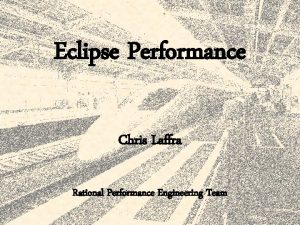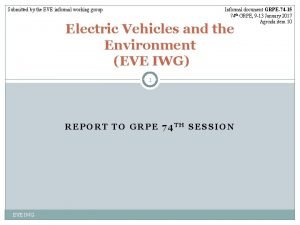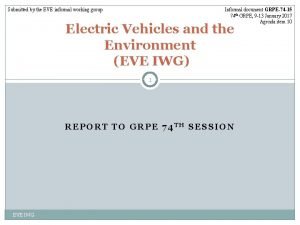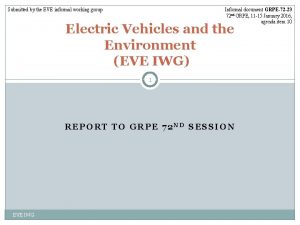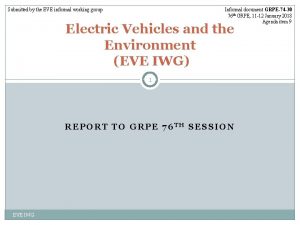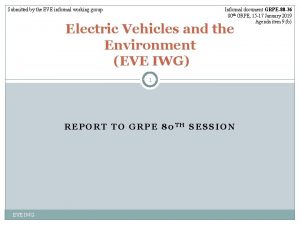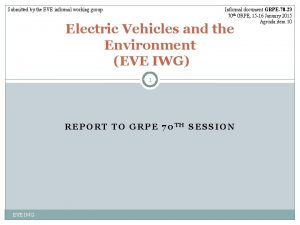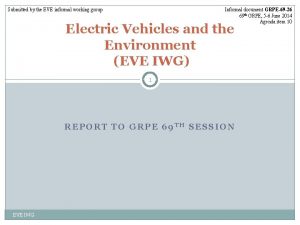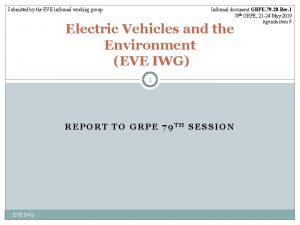GRSGVRUProxi Informal Working Group Japan Proposals for Technical











- Slides: 11

GRSG/VRU-Proxi Informal Working Group Japan Proposals for Technical Requirements on Sonars November 21 th 2017 Tokyo

Table of Contents 1. Basic Ideas for Developing Technical Requirements on Sonars under GRSG 2. Proposals for Technical Requirements on Sonar system for VRUs detection 1

1. Basic Ideas for Developing Technical Requirements on Sonars under GRSG • ISO 17386 (MALSO(*)) is a technical requirements on sonar system. • As ISO 17386 is aimed for assisting driver to understand the distance to various objects, such as wall, thin pole, luggage carrier of truck, etc. in parking scene , some modification is necessary for the purpose of VRUs detection. • Our proposal is to make new requirement based for the purpose of VRUs detection by modifying ISO 17386. *: MALSO: Maneuvering Aids for Low Speed Operation 2

Reference: ISO 17386 MALSO ○Outline of ISO 17386 • Requirements on sonars and other sensing technologies Detection areas • Detection areas: Front, rear, corner Requirements specified for each area (detection area, response time, etc. ) • Main rearward detection requirements - Detection area: 1 m max. in the rear - Detection area requirement: The area shall be divided into 0. 1 x 0. 1 m grids and a target (φ75 mm, H 1000 mm) shall be located there. Testing shall determine whether or not each grid can be detected. - Detection latency: The detection latency standard for when the target appears within the area is also specified. Rear Front Corner Image of a test in the rear horizontal area Target Detected Not Detected Vehicle 0. 6 m 1 m 3

2. Proposals for Technical Requirements on Sonars Modification points of ISO 17386 for the purpose of VRUs detection ISO 17386 (Clause 5) 5. 1 System activation Issue, etc. The automatic activation requirement is unnecessary except for reversing. Proposals for technical requirements on sonar system for VRUs detection Delete provisions except those related to reversing. 5. 2 Driver interface and information strategy - (As per ISO’s requirements) 5. 3. 1 Relative velocity of objects Dynamic 5. 3. 2 Start-up detection delay performance 5. 3. 3 Detection latency of object detection - (As per ISO’s requirements) - Add definition. The specified test procedures are not appropriate (unrealistic Newly specify realistic test procedures. (See 2. 1) situation for VRUs detection). The average detection latency requirement is unnecessary (because its purpose is to ensure merchantability). 5. 4. 1 Sections of the monitoring range Two sections of the rear detection area (0. 6 m or 1 m) Monitoring 5. 4. 2 Horizontal areas of relevance This clause is unnecessary for VRUs detection (with many range items that are redundant with Clause 5. 4. 3). coverage 5. 4. 3 Rear horizontal area - Delete the average detection latency requirement. Choose the 1 -m section. Delete (and incorporate into Clause 5. 4. 3). (Use Clause 7 for test procedures. ) 5. 4. 4 Front horizontal area This requirement is unnecessary for VRUs detection (because it. Delete. concerns areas other than the rear field of vision). 5. 4. 5 Corner horizontal areas This requirement is unnecessary for VRUs detection (because it. Delete. concerns areas other than the rear field of vision and its purpose is to avoid property damage). 5. 4. 6 Minimum coverage ratios The requirement "no more than two contiguous detection holes" needs to be modified for VRUs detection. 5. 4. 7 Vertical areas of relevance This requirement is unnecessary for VRUs detection (because Delete. its purpose is to avoid property damage). Relax the requirement to the size equivalent to that of a person. (See 2. 2. ) 5. 5 Self-test capabilities and failure indication - (As per ISO’s requirements) 5. 6 Operation with trailers - (As per ISO’s requirements) (See 2. 3. ) 4

2. 1. Detection Latency Test Procedures (1) ISO 17386 • The target is dropped from a height of 1 m and the response time is measured (video camera image audible warning). • A situation where the detection target is landing from above is unrealistic for VRUs detection Audible warning system Target Dropped from a height of 1 m Microphone Detection area Microphone System warning height Video camera Recording 5

(2) Proposal for the response time measurement • The system response time should be measured with the time duration from selecting the reverse gear to the warning activation for a stationary target placed in valuation area. Audible warning system Gearshift Target having been placed within the area in advance Recording Microphone Detection area Video camera Microphone Filming the gearshift lever operation and recording the audible warning 6

2. 2. Minimum Coverage Ratios (1) ISO 17386 • ISO’s requirement “there shall be no more than two contiguous detection holes”(*1) is to avoid property damage by thin object such as pole. (2)Proposal for minimum coverage • It is sufficient if the target covers grids equivalent to the size of a person for VRUs detection. • Change to “no more than 2 x 2 undetected grids” which considered as equivalent to the size of a pedestrian. Image of the undetected grids requirement Proposal: No more than 2 × 2 undetected grids Target in the field of vision requirement: φ300 mm 0. 1 m Detected Not Detected ISO’s requirement (No more than two contiguous detection holes) *1: Within the whole monitoring range, there shall be no more than two contiguous detection holes in a straight line, either horizontally, vertically or diagonally in the horizontal plane. *2: VRU-Proxi-02 -03 7

2. 3. Vertical Range Requirement (1)ISO 17386 • Vertical range requirement (see below) is defined to avoid property damage by various object, such as luggage carrier of truck. (2)Proposal • Delete vertical range test Target in the proposed field of vision requirement (H 1000 mm) 0. 8 m ISO’s target 0. 2 m 0. 1 m 1 m 8

Supplementary Information 9

Reference: Reversing Speed Models Studied by ISO Speed (m/s) Simplified model of speeds used by the driver Speed at which the vehicle is 1 m from the object in the rear Model of speeds used by the driver Distance to the object (m) Source: The Commentary section of “JIS D 0803: 0000 (ISO 17386: 2010) Transport information and control systems 10 Manoeuvring Aids for Low Speed Operation (MALSO) - Performance requirements and test procedures”
 Difference between formal and informal proposals
Difference between formal and informal proposals Title of the study
Title of the study Prefatory and supplementary part of proposal
Prefatory and supplementary part of proposal Writing and completing reports and proposals
Writing and completing reports and proposals Artificial intelligence thesis proposals
Artificial intelligence thesis proposals Solicited external
Solicited external Functions of fire insurance
Functions of fire insurance When evaluating cost-cutting proposals
When evaluating cost-cutting proposals Developing effective research proposals
Developing effective research proposals Eclipse computing proposals slow
Eclipse computing proposals slow Delhi muslim proposals
Delhi muslim proposals Smart work vs hard work
Smart work vs hard work









